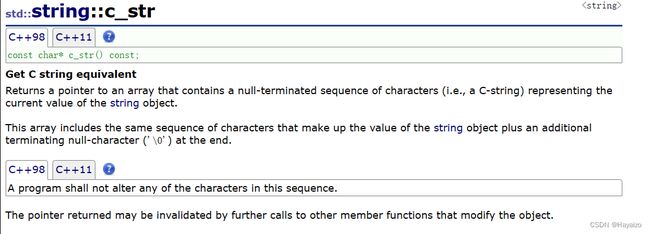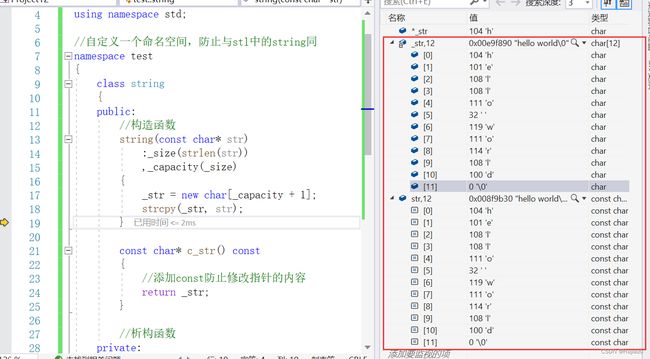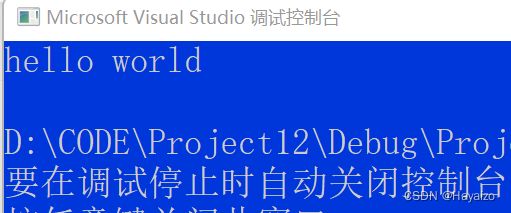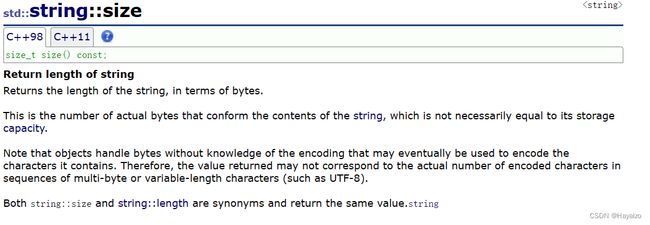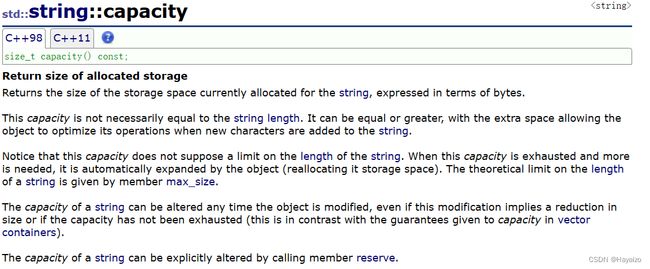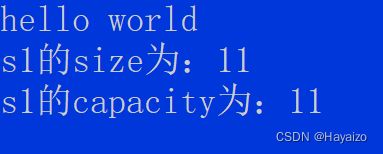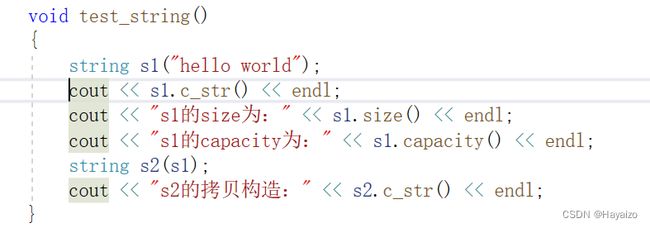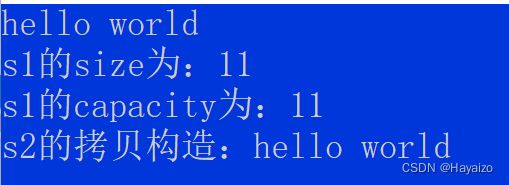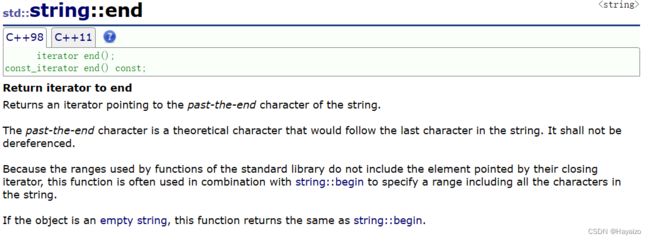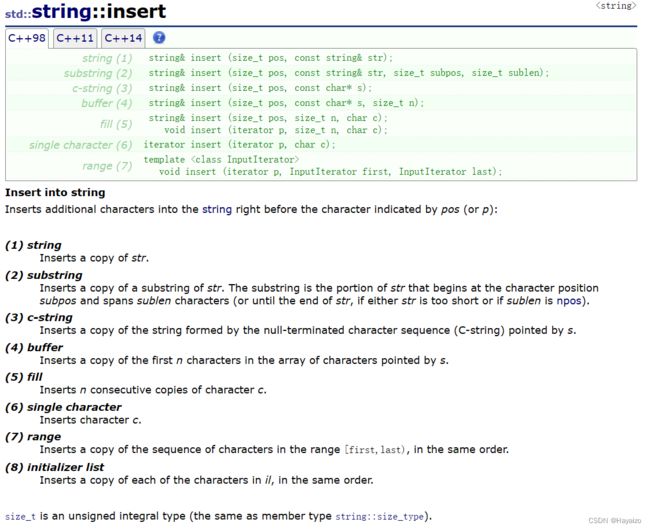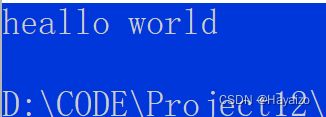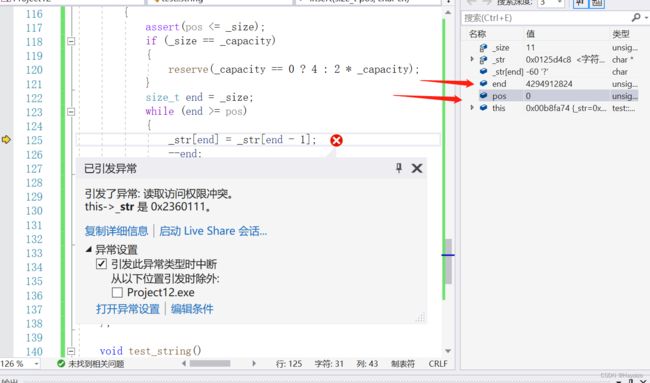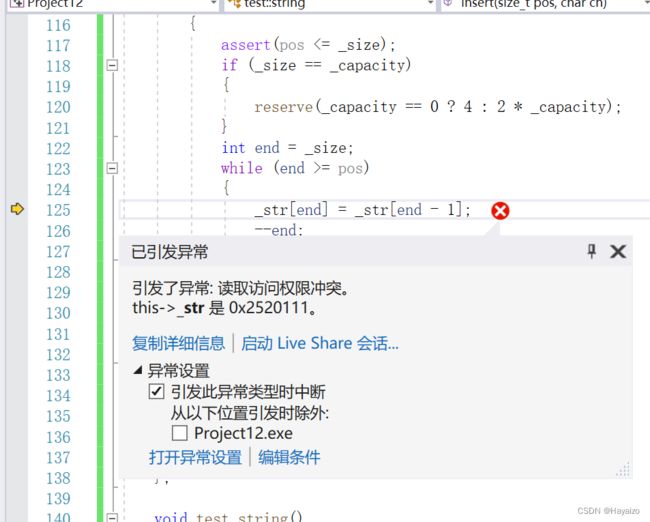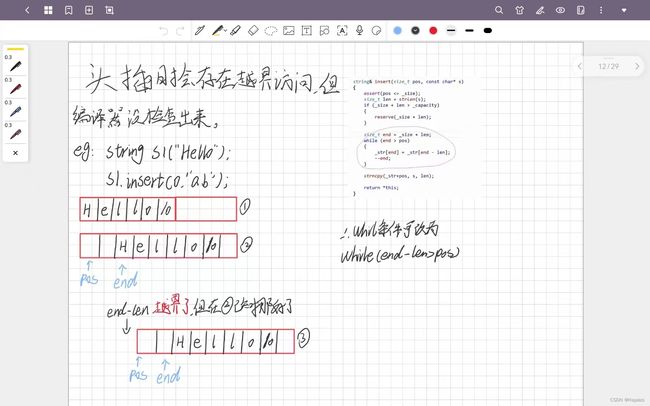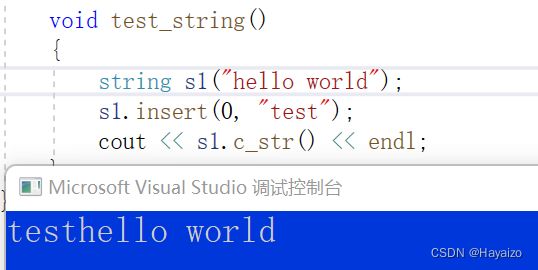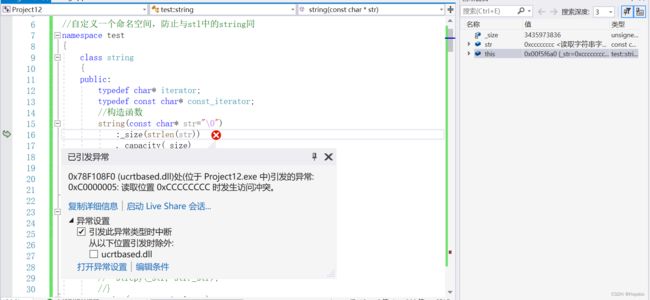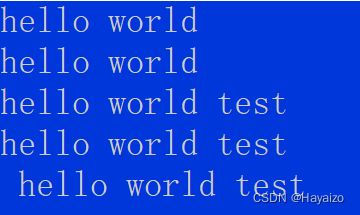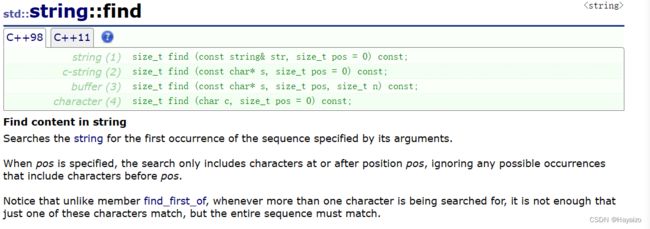详解C++模拟实现string类
目录
准备
构造函数
c_str
size
capacity
析构函数
拷贝构造
swap
operator[ ]
迭代器iterator的实现
begin
end
reserve
insert在任意位置插入字符/字符串
push_back
append
operator+
operator+=
erase
clear
pop_back
比较函数
substr
find(利用kmp算法实现)
kmp详解可移步至:KMP算法详解(一眼看穿next[ ]数组)
>>
<<
准备
为了自己创建的string类不和库当中的发生冲突,可以自己创建一个命名空间
namespace test
{
}string需要三个参数,一个存放字符串(char* _str),一个存放大小(size_t _size),一个存放容量(size_t _capacity)
//自定义一个命名空间,防止与stl中的string同
namespace test
{
class string
{
public:
//构造函数
string()
{
}
//析构函数
private:
char* _str;
size_t _size;
size_t _capacity;
};
}构造函数
构造函数需要做的就是对成员进行初始化,由于字符串是常量,类型为const char*,所以接收的时候也需要用const char*来接收,但这里不能简单的直接将str给_str,因为str是存放在常量区的,如果直接将_str=str,会将str在常量区的地址也拷贝过去,会导致之后无法修改string的内容,所以需要给_str分配一个空间,然后再将str的值全部拷贝过去,在分配空间的时候要多分配一个空间给'\0'
string(const char* str)
:_size(strlen(str))
,_capacity(_size)
{
_str = new char[_capacity + 1];
strcpy(_str, str);
}为了方便测试函数是否正确,提供一个c_str函数来获取对象中的字符串
c_str
官方解释:
函数类型是const char*因为这只是一个提取对象内容的函数,为了防止权限放大,因为某些原因导致指针被修改就麻烦大了
返回一个指针包括'\0'的字符串
const char* c_str() const
{
//添加const防止修改指针的内容
return _str;
}测试一下构造函数,传一个hello world
运行结果:
再提供两个接口来获取size和capacity
size
官方解释:
首先返回类型为size_t,大小肯定不会为负数,用const修饰
返回的是字符串的实际长度,不包括'\0',也不是容量的大小
size_t size() const
{
return _size;
}capacity
官方解释:
和size差不多,返回的容量不包括'\0'
size_t capacity() const
{
return _capacity;
}运行结果:
运行结果是正确的,但这里存在两个构造函数,第一种是默认的
string()
{
}第二种就是我们自主实现的,其实这里可以简化一下,将两种合并为一种,在传的字符串为空的时候就会调用第一种构造函数,空的话字符串内容就是'\0',_capacity=0,_size=0,可以直接将第二种构造函数的参数给个缺省值,如果不填就默认是""或者"\0",这两种是等效的,第一种也是直接填一个'\0'上去,所以构造函数也可以写成:
string(const char* str="")
:_size(strlen(str))
,_capacity(_size)
{
_str = new char[_capacity + 1];
strcpy(_str, str);
}或者:
string(const char* str="\0")
:_size(strlen(str))
,_capacity(_size)
{
_str = new char[_capacity + 1];
strcpy(_str, str);
}析构函数
成员变量中_str是动态开辟出来的,所以需要对内存进行delete释放,释放后再将其指向nullptr空
~string()
{
delete[] _str;
_str = nullptr;
_size = 0;
_capacity = 0;
}拷贝构造
思路1:
对_str重新分配空间,然后利用strcpy函数来讲str中的字符串全部拷贝到_str中
string(const string& str)
:_size(str._size)
,_capacity(str._capacity)
{
_str = new char[_capacity + 1];
strcpy(_str, str._str);
}测试:
运行结果:
思路2:
创建一个临时变量tmp来拷贝str,再通过swap函数来交换,因为tmp是临时变量,出了函数作用域就会调用析构函数来销毁tmp,所以在tmp和str交换之后,因为str的原地址需要被销毁,这里就不需要手动销毁了,我们将str的地址给到了tmp,出了函数作用域之后调用析构函数就将其销毁了。
string(const string& str)
:_str(nullptr)
,_size(0)
,_capacity(0)
{
string tmp(str._str);
swap(tmp);
}swap
全局的那个swap对于内置类型交换很快,但对于自定义类型会比较慢了,它会掉用三次构造函数,所以可以自己实现一个swap函数
void swap(string& str)
{
string tmp(str._str);
std::swap(_str, tmp._str);
std::swap(_size, tmp._size);
std::swap(_capacity, tmp._capacity);
}operator[ ]
对操作符[ ]进行重载,可以通过[ ]来获取字符
官方解释:
char& operator[](size_t pos)
{
assert(pos < _size);
return _str[pos];
} const char& operator[](size_t pos) const
{
assert(pos < _size);
return _str[pos];
}迭代器iterator的实现
iterator实质上就是一个类似指针的东西但又不是指针,但是在string类中可以将其当作指针,所以对iterator进行重命名即可
typedef char* iterator;begin
官方解释:
返回第一个字符的指针
iterator begin()
{
return _str;
} const_iterator begin() const
{
return _str;
}end
官方解释:
返回的是字符串最后一个字符的后一个位置的指针,比如一个字符串为"hello world\0",end()指向的就是'\0'的位置
iterator end()
{
return _str + _size;
} const_iterator end() const
{
return _str + _size;
}测试:
void test_string()
{
string s1("hello world");
for (test::string::iterator it = s1.begin(); it < s1.end(); ++it)
{
cout << *it << " ";
}
}输出结果:
reserve
官方解释:
该函数对字符串内容不能进行修改,大小也不能修改,只能增加其容量,并且只能增容不能缩容
所以可以通过创建一个临时变量tmp,大小为n+1,将_str的内容通过strcpy函数复制给tmp,然后将_str给delete[ ]掉,最后将tmp地址给_str,就实现了扩容。
void reserve(size_t n = 0)
{
assert(n > _capacity);
char* tmp = new char[n + 1];
strcpy(tmp, _str);
delete[] _str;
_str = tmp;
_capacity = n;
}insert在任意位置插入字符/字符串
官方解释:
string& insert(size_t pos, char ch)
{
assert(pos <= _size);
if (_size == _capacity)
{
reserve(_capacity == 0 ? 4 : 2 * _capacity);
}
size_t end = _size;
while (end >= pos)
{
_str[end] = _str[end - 1];
--end;
}
_str[pos] = ch;
++_size;
_str[_size] = '\0';
return *this;
}这样的代码看起来是没有什么问题,下面进行测试:
void test_string()
{
string s1("hello world");
s1.insert(2, 'a');
cout << s1.c_str() << endl;
}运行结果:
看起来好像一切都正常,但进行头插的时候
void test_string()
{
string s1("hello world");
s1.insert(0, 'a');
cout << s1.c_str() << endl;
}这里导致程序崩溃的原因是因为end和pos都是size_t类型,size_t的0是一个很大的数,所以导致这里死循环了,但如果将end的类型从size_t改成int,程序还是会报错
而这里报错的原因是存在一个隐式类型转换,end>=pos这个式子当中,end是int类型,pos是size_t类型,int会自动转换成size_t,所以这里改成int类型也是没有用的,除非全都改成int类型,但库当中使用的类型是size_t,我们不能因为实现这个功能将库中变量的类型都改变了,这里有两种解决方式,一种是利用指针,还有一种就是另end=_size+1,只要不判断0就不会出错了
指针的方式:
string& insert(size_t pos, char ch)
{
assert(pos <= _size);
if (_size == _capacity)
{
reserve(_capacity == 0 ? 4 : 2 * _capacity);
}
char* end = _str + _size;
char* target = _str + pos;
size_t end1 = _size;
while (end >= target)
{
_str[end1] = _str[end1 - 1];
--end;
--end1;
}
_str[pos] = ch;
++_size;
_str[_size] = '\0';
return *this;
}不判断0的方式:
string& insert(size_t pos, char ch)
{
assert(pos <= _size);
if (_size == _capacity)
{
reserve(_capacity == 0 ? 4 : 2 * _capacity);
}
size_t end = _size + 1;
while (end > pos)
{
_str[end] = _str[end - 1];
--end;
}
_str[pos] = ch;
++_size;
_str[_size] = '\0';
return *this;
}如果是插入一个字符串呢?其实思路也是一样的
string& insert(size_t pos, const char* str)
{
assert(pos <= _size);
int len = strlen(str);
size_t end1 = _size + len;
if (_capacity == _size)
{
reserve(_capacity + len);
}
char* end = _str + _size + len;
char* target = _str + pos;
while (end >= target)
{
_str[end1] = _str[end1 - len];
--end1;
--end;
}
strncpy(_str + pos, str, len);
return *this;
}不判断0的方式:
string& insert(size_t pos, const char* str)
{
assert(pos <= _size);
int len = strlen(str);
size_t end = _size + len;
if (_capacity == _size)
{
reserve(_capacity+len);
}
while (end-len > pos)
{
_str[end] = _str[end - len];
--end;
}
strncpy(_str + pos, str, len);
return *this;
}继续测试:
void test_string()
{
string s1("hello world");
s1.insert(0, "test");
cout << s1.c_str() << endl;
}push_back
官方解释:
插入一个字符到字符串的结尾,并且_size+1。
首先判断是否需要扩容,然后再在_str[_size]进行插入字符,最后++_size。
void push_back(char ch)
{
if (_size == _capacity)
{
reserve(_capacity + 1);
}
_str[_size] = ch;
++_size;
_str[_size] = '\0';
}开始测试:
void test_string()
{
string s1("hello world");
string s2("");
string s3(" ");
s1.push_back('a');
s2.push_back('a');
s3.push_back('a');
cout << "s1的size:" << s1.size() << " " << "s1的capacity:" << s1.capacity() << " " << "字符串为:" << s1.c_str() << endl;
cout << "s2的size:" << s2.size() << " " << "s2的capacity:" << s2.capacity() << " " << "字符串为:" << s2.c_str() << endl;
cout << "s3的size:" << s3.size() << " " << "s3的capacity:" << s3.capacity() << " " << "字符串为:" << s3.c_str() << endl;
}其实为了简化代码也可以直接调用insert函数
void push_back(char ch)
{
insert(_size, ch);
}append
也是在字符串的结尾进行插入,与push_back不同的就是push_back只能插入字符但append还能插入字符串,函数返回类型也不同,所以插入字符的就不说了。
插入字符串,首先判断是否需要扩容,然后进行字符串尾插
string& append(const char* str)
{
int len = strlen(str);
if (_capacity < _size + len)
{
reserve(_size + len);
}
strcpy(_str + _size, str);
_size += len;
return *this;
}测试:
void test_string()
{
string s1("hello world");
string s2("");
string s3(" ");
s1.append("test");
s2.append("test");
s3.append("test");
cout << "s1的size:" << s1.size() << " " << "s1的capacity:" << s1.capacity() << " " << "字符串为:" << s1.c_str() << endl;
cout << "s2的size:" << s2.size() << " " << "s2的capacity:" << s2.capacity() << " " << "字符串为:" << s2.c_str() << endl;
cout << "s3的size:" << s3.size() << " " << "s3的capacity:" << s3.capacity() << " " << "字符串为:" << s3.c_str() << endl;
}为了代码简洁也是可以直接调用insert函数来实现append函数的功能
string& append(const char* str)
{
insert(_size, str);
return *this;
}operator+
string operator+(const string& s2)
{
char* tmp = new char[strlen(s2._str) + strlen(_str) + 1];
strcpy(tmp, _str);
strcat(tmp, s2._str);
string res(tmp);
delete[] tmp;
tmp = nullptr;
return res;
}测试:
void test_string()
{
string s1("hello world");
string s2("");
string s3(" ");
string s4 = s1 + s2;
string s5 = s2 + s1;
string s6 = s2 + s3;
string s7 = s3 + s2;
string s8 = s1 + s3;
string s9 = s3 + s1;
cout << "s4的size:" << s4.size() << " " << "s4的capacity:" << s4.capacity() << " " << "字符串为:" << s4.c_str() << endl;
cout << "s5的size:" << s5.size() << " " << "s5的capacity:" << s5.capacity() << " " << "字符串为:" << s5.c_str() << endl;
cout << "s6的size:" << s6.size() << " " << "s6的capacity:" << s6.capacity() << " " << "字符串为:" << s6.c_str() << endl;
cout << "s7的size:" << s7.size() << " " << "s7的capacity:" << s7.capacity() << " " << "字符串为:" << s7.c_str() << endl;
cout << "s8的size:" << s8.size() << " " << "s8的capacity:" << s8.capacity() << " " << "字符串为:" << s8.c_str() << endl;
cout << "s9的size:" << s9.size() << " " << "s9的capacity:" << s9.capacity() << " " << "字符串为:" << s9.c_str() << endl;
}这里的代码实现我刚开始犯了一个错误,将返回类型string写成了&string,这会导致程序直接崩溃
对不可操作的内存进行strlen了。
由于s1+s2返回的是一个不可操作的内存,因为res是string自定义类型的临时对象,出了函数作用域就会调用析构函数,析构函数会直接将res对象中的_str给delete[ ]销毁掉,但这个res又传过来了,所以s4又会去调用构造函数,所以就出问题了
operator+=
官方解释:
通过在字符串的当前值末尾附加其他字符来扩展字符串
首先要判断是否需要扩容,然后利用strcpy函数将str._str的字符串内容全部复制过去
string& operator+=(const string& str)
{
if (_size + str._size > _capacity)
{
reserve(_size + str._size);
}
strcpy(_str + _size, str._str);
_size += str._size;
return *this;
}测试:
void test_string()
{
string s1("hello world");
string s2("test");
string s3("");
string s4(" ");
s1 += s3;
cout << s1.c_str() << endl;
s1 += s4;
cout << s1.c_str() << endl;
s1 += s2;
cout << s1.c_str() << endl;
s3 += s1;
cout << s3.c_str() << endl;
s4 += s1;
cout << s4.c_str() << endl;
}运行结果:
也可以为了写的更加简洁,直接调用之前写的append函数即可
string& operator+=(const char* str)
{
append(str);
return *this;
}erase
官方解释:
npos就是size_t -1
删除部分字符串,减少字符串长度。
private:
char* _str;
size_t _size;
size_t _capacity;
static const size_t npos;然后再类外面对npos进行初始化,为什么npos不在初始化列表中初始化呢?
因为npos是一个静态变量,它不属于某一个特定的对象,所以要在类外面对其进行初始化,并且要指定类域
const size_t string::npos = -1;如果pos比字符串的长度还要大,直接报错。
如果pos+len>=_size,那么直接将_str[pos]位置改为'\0'。
string& erase(size_t pos = 0, size_t len = npos)
{
assert(pos < _size);
if (len == npos || pos + len >= _size)
{
_str[pos] = '\0';
_size = pos;
}
else
{
strncpy(_str + pos, _str + pos + len,len);
_size -= len;
}
return *this;
}测试:
void test_string()
{
string s1("hello world");
s1.erase(0, 10);
cout << s1.c_str() << endl;
string s2("hello world");
s2.erase(10, 5);
cout << s2.c_str() << endl;
}运行结果:
clear
官方解释:
消去字符串的内容成为一个空字符串,_size和_capacity都变为0
void clear()
{
delete[] _str;
_capacity = 0;
_size = 0;
}pop_back
void pop_back()
{
assert(_size > 0);
_str[_size-1] = '\0';
--_size;
}比较函数
bool operator >(const string& s) const
{
return strcmp(_str, s._str) > 0;
}
bool operator ==(const string& s) const
{
return strcmp(_str, s._str) == 0;
}
bool operator >= (const string& s) const
{
return *this > s || *this == s;
}
bool operator <(const string& s) const
{
return !(*this >= s);
}
bool operator <=(const string& s) const
{
return !(*this > s);
}
bool operator !=(const string& s)
{
return !(*this == s);
}substr
官方解释:
返回一个新构造的对象,其值初始化为此对象的子字符串的拷贝。
子字符串是从字符位置开始并跨越字符(或直到字符串末尾,以先到者为准)的对象部分。
string substr(size_t pos = 0, size_t len = npos)
{
assert(pos < _size);
size_t reallen = len;
if (len == npos || pos + len > _size)
{
reallen = _size - len;
}
string sub;
for (int i = pos; i < reallen; ++i)
{
sub += _str[i];
}
return sub;
}find(利用kmp算法实现)
官方解释:
从pos位置开始,在字符串中找到第一个匹配的下标并且返回
首先是查找单个字符,很简单,直接遍历挨个比对就好了
size_t find(char ch, size_t pos = 0)//查找字符
{
for (int i = pos; i < _size; i++)
{
if (_str[i] == ch)
{
return i;
}
}
return npos;
}其次就是匹配字符串了,这里使用的是kmp算法来匹配子串并且返回其下标
kmp详解可移步至:KMP算法详解(一眼看穿next[ ]数组)
size_t find(const char* str, size_t pos = 0)
{
int len = strlen(str);
if (strlen(str) > _size)
{
return npos;
}
ne = new int[len + 1]{ 0 };
//获取匹配码
for (int i = 1, j = 0; i < len; i++)
{
while (j && str[i] != str[j]) j = ne[j];
if (str[i] == str[j]) j++;
ne[i] = j;
}
for (int i = 0, j = 0; i < _size; i++)
{
while (j && _str[i] != str[j]) j = ne[j];
if (_str[i] == str[j]) j++;
if (j == len)
{
return i - j + 1;
}
}
return npos;
}注意到这里使用到了一个ne数组,ne数组主要是用来存储字符串的匹配码的,这个ne数组直接定义在私有成员变量当中,int* ne;
private:
char* _str;
size_t _size;
size_t _capacity;
int* ne;
static const size_t npos;成员变量添加了一个ne指针之后,也需要在构造函数中对ne指针进行初始化,否则ne指向的是一片随机的空间,由于无法直接在初始化列表当中给ne分配空间,所以可以先给ne一个空指针。
string(const char* str = "")
:_size(strlen(str))
, _capacity(_size)
, ne(nullptr)
{
ne = new int[1]{ 0 };
_str = new char[_capacity + 1];
strcpy(_str, str);
}>>
官方解释:
在C++当中,处理输入时使用命名为cin的istream类型对象,这个对象也叫标准输入,每次输入操作符实例都要接受两个操作数:左操作数必须是istream对象,然后接受一个对象作为右操作数,它从istream操作数当中读取数据并且保存在右操作数中。
因为>>是操作符,只能接收一个参数,如果不使用友元的话调用这个函数的书写方式会变为:
str.cin("test");这显然不符合正常使用的习惯,所以这里需要添加一个友元函数
friend istream& operator>>(istream& in, string& str);然后再实现cin
istream& operator>>(istream& in, string& str)
{
str.clear();//清空原字符串
char ch = in.get();
while (ch != ' ' && ch != '\n')
{
ch = in.get();
}
return in;
}
<<
<<为流提取,与>>类似,不过它的左值是一个ostream类型的对象
友元函数:
friend ostream& operator<<(ostream& out, const string& str);实现cout:
ostream& operator<<(ostream& out, const string& str)
{
out << str.c_str();
return out;
}
